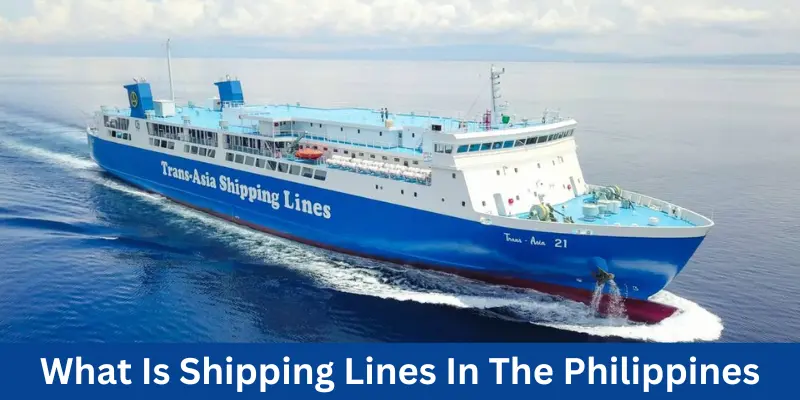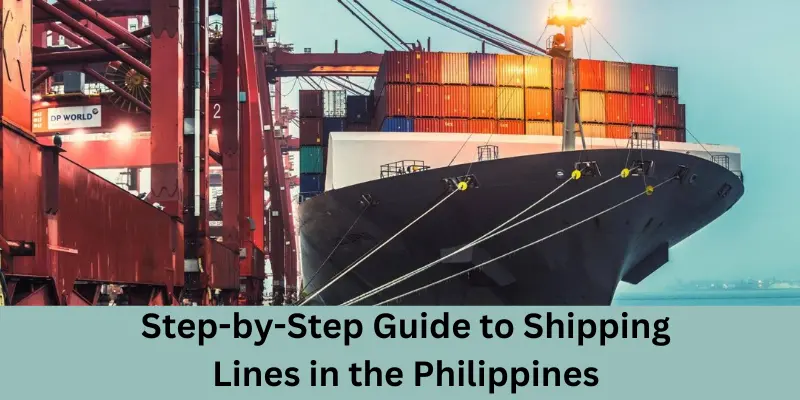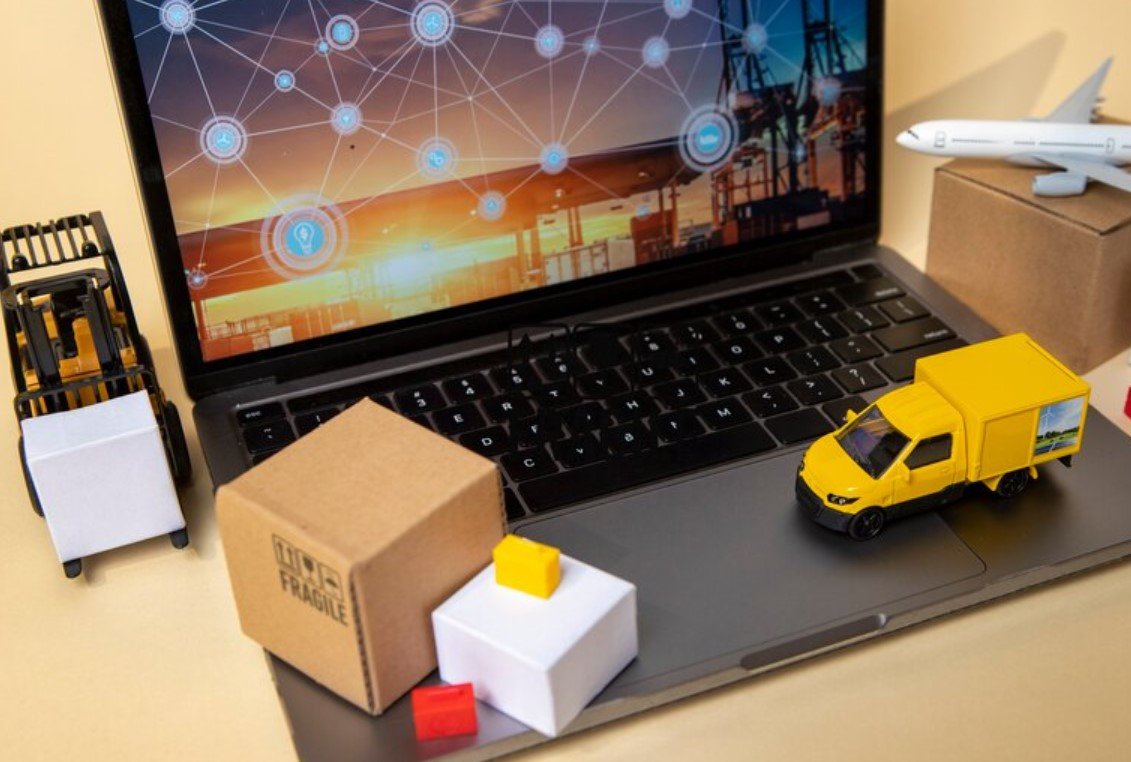Introduction
Shipping Lines In The Philippines, an archipelago of over 7,000 islands, relies heavily on its shipping industry for both economic growth and everyday connectivity. With waterways serving as vital links between islands, shipping lines play a crucial role in transporting goods, people, and resources efficiently across the country and beyond.
From domestic ferries that connect bustling cities to serene island destinations to international cargo carriers facilitating global trade, the Philippine shipping sector is diverse and dynamic. With advancements in technology and a growing emphasis on sustainability, shipping lines are evolving to meet modern demands. Whether you are a business looking to transport goods or a traveler seeking inter island adventures, the countrys shipping lines offer a variety of options tailored to different needs.
Table of Contents
What Is Shipping Lines In The Philippines?

Shipping lines in the Philippines are companies that help move people and goods between the many islands of the country and even to other parts of the world. Imagine you live on one island, and you want to send a box of mangoes to a friend on another island or travel to a different place for a vacation shipping lines make this possible.
These companies use big ships, ferries, and boats to carry passengers, cargo, and even vehicles like cars and trucks. They are very important because the Philippines is made up of over 7,000 islands, and roads can not connect all of them. Shipping lines help connect everyone, making it easier for families, businesses, and tourists to get where they need to go.
Some of the well known shipping lines in the Philippines are 2GO Travel, Trans Asia Shipping, and Starlite Ferries, which offer services like ferry rides, cargo transport, and more. These companies make travel and shipping safe, fast, and reliable.
You May Also Like It!
Volunteer Hartlepool | Fun Ways to Help Your Town
Liquid Illuminator | Simple Tips for a Natural Glow
How to Become an Affiliate of the Jama rocks Cruise Line
Exploring Music Communities Like CLLV to Fuel Your Passion
Why Are Shipping Lines in the Philippines Important?
Shipping lines play a vital role in the Philippines, a country made up of thousands of islands.
1. Connecting Islands and Communities
- Provide vital transportation for people traveling between islands.
- Help remote communities access goods, services, and opportunities.
- Facilitate family connections and tourism by enabling travel across the archipelago.
2. Supporting Trade and Businesses
- Move products like food, clothing, and electronics between islands and to international markets.
- Enable small businesses and large industries to distribute goods efficiently.
- Provide cost effective logistics for importing and exporting goods.
3. Boosting Tourism
- Offer convenient travel for tourists exploring the country beautiful islands.
- Provide access to popular destinations like Boracay, Palawan, and Cebu.
- Contribute to the growth of the local economy by attracting visitors.
4. Strengthening the Economy
- Support agriculture and fishing industries by transporting products to markets.
- Create jobs for people working in ports, on ships, and in logistics services.
- Contribute to national and regional development by improving trade routes.
5. Enhancing Emergency Response
- Deliver essential supplies during disasters, such as food and medical aid.
- Evacuate people from affected areas during typhoons or floods.
- Support rebuilding efforts by transporting construction materials.
6. Promoting Environmental Sustainability
- Modern shipping lines adopt eco friendly practices to reduce pollution.
- Encourage the use of greener fuels and energy efficient technologies.
- Reduce the reliance on air and land transport, which can have higher carbon footprints.
Shipping lines are more than just a way to travel or ship items they are a lifeline for the country economy, connectivity, and progress.
Step-by-Step Guide to Shipping Lines in the Philippines

Here a complete guide to understanding and navigating shipping lines in the Philippines:
Step 1: Understand the Role of Shipping Lines
- Shipping lines are essential for transporting goods and passengers across the Philippines many islands and to other countries.
- They handle domestic trips, international trade, and specialized services like bulk cargo and vehicle transport.
Step 2: Identify Your Needs
- Passenger Travel: Look for ferries or cruise services like 2GO Travel for inter island trips.
- Cargo Shipping: Choose companies like Trans Asia Shipping Lines for transporting goods.
- Specialized Shipping: Find services for unique needs such as refrigerated goods, oversized cargo, or vehicles.
Step 3: Research Available Shipping Lines
- 2GO Travel: Offers passenger and cargo services across popular routes.
- Trans Asia Shipping Lines: Focuses on cargo and ferry services in Visayas and Mindanao.
- Starlite Ferries: Specializes in RORO (Roll On/Roll Off) services.
- Use online directories or official websites to explore other options like Lite Shipping and Montenegro Lines.
Step 4: Compare Services and Routes
- Check the routes serviced by the shipping line to ensure it meets your destination needs.
- Evaluate travel times, prices, and the type of vessel (ferries, cargo ships, or RORO).
Step 5: Book Your Service
- For Passengers: Visit the company website or go to their booking offices to reserve tickets.
- For Cargo: Contact the shipping line directly for quotes and instructions on preparing your shipment.
- Use online platforms or apps for added convenience and to track availability.
Step 6: Prepare for Travel or Shipment
- For Passengers: Bring valid identification and follow boarding instructions. Arrive early to avoid delays.
- For Cargo: Ensure goods are properly packed and labeled. Some companies require specific documentation for certain items.
Step 7: Follow Safety Protocols
- Adhere to the rules on safety and security, especially for large shipments or when traveling with children or pets.
- Confirm details about prohibited items or special accommodations.
Step 8: Use Tracking and Customer Support
- Many shipping lines offer online tracking for cargo shipments.
- Contact customer support for any issues or updates about delays or changes in schedules.
Step 9: Stay Updated on Changes
- Be aware of weather conditions that may affect schedules, especially during typhoon season.
- Subscribe to alerts or check for updates from the shipping line official channels.
Step 10: Evaluate and Share Feedback
- After your trip or shipping experience, share your feedback through online reviews or surveys to help others make informed choices.
This step by step guide ensures you navigate shipping lines in the Philippines effectively, whether you are booking a passenger trip or transporting goods.
You May Also Like It!
Fashion Show para Ejecutivas | Professional Outfits for Women in Business
Pentahydrate for Ellmans Condensation | Benefits, Applications and Alternatives
Condensation | Discover the Magic of Water Drops
Copper Sulfate | Uses and Safety Guide
Advantages and Disadvantages of Shipping Lines in the Philippines
The shipping industry in the Philippines is a backbone of connectivity and commerce for this archipelagic nation. While it offers numerous benefits, it also faces certain challenges.
Advantages of Shipping Lines in the Philippines
| Advantages |
| Connectivity Across Islands Shipping lines provide essential transport for goods and passengers between the over 7,000 islands of the Philippines. Enables communities in remote and rural areas to access vital resources and economic opportunities. |
| Cost Effective Transport Compared to air travel or trucking for large cargo, shipping is generally more affordable for inter island transport. Bulk goods like agricultural products can be shipped at lower rates. |
| Economic Boost Facilitates domestic and international trade, supporting industries like agriculture, manufacturing, and tourism. Generates employment opportunities in logistics, port operations, and maritime professions. |
| Tourism Growth Provides accessible travel options for tourists exploring famous island destinations like Cebu, Palawan, and Boracay. Ferry services enhance the experience of traveling within the country. |
| Sustainability Shipping generally has a lower carbon footprint per ton mile compared to air and land transport. Some companies are adopting eco friendly practices and modern vessels to further reduce environmental impact. |
| Disaster Response Plays a critical role in delivering relief goods and evacuating people during natural disasters like typhoons and earthquakes. |
Disadvantages of Shipping Lines in the Philippines
| Disadvantages |
| Weather Dependency Shipping schedules are often affected by weather conditions, especially during typhoon season, leading to delays or cancellations. Safety concerns increase during rough seas. |
| Port Congestion Major ports like Manila often experience congestion, leading to inefficiencies and delays in loading/unloading goods. Smaller ports may lack the infrastructure to handle large volumes. |
| Limited Speed Ships are slower compared to air travel, making them less ideal for time sensitive deliveries or urgent trips. |
| Maintenance and Safety Concerns Aging fleets and poorly maintained vessels can pose safety risks for passengers and cargo. Some smaller shipping operators may not adhere to stringent safety standards. |
| Environmental Challenges Despite being more eco friendly than air transport, ships still contribute to marine pollution, including oil spills and waste disposal issues. Overcrowding and overuse of certain routes can harm marine ecosystems. |
| Regulatory and Operational Issues Some shipping lines face regulatory hurdles or operational inefficiencies that can lead to poor service quality. Issues like corruption or mismanagement in port operations can impact reliability. |
Shipping lines in the Philippines are a vital part of the nations infrastructure, supporting economic growth, connectivity, and disaster response. However, addressing challenges like safety, port congestion, and environmental impact is crucial for the industry to realize its full potential. By balancing its advantages with solutions for its drawbacks, the Philippine shipping industry can continue to thrive and serve its people effectively.
Frequently Asked Questions (FAQs) About Shipping Lines in the Philippines
Some Common Faqs of Shipping Lines in the Philippines:
1. What are shipping lines in the Philippines?
Shipping lines in the Philippines are companies that provide transport services for passengers and cargo between the country islands and even to other countries. These companies use ships, ferries, and other vessels to move goods, people, and vehicles across the archipelago.
2. Why are shipping lines important in the Philippines?
Shipping lines are crucial for the Philippines because they connect over 7,000 islands. They help businesses transport goods across islands, support tourism, and allow people to travel to different regions of the country. They also play a vital role in emergency response, such as during natural disasters.
3. How do I book a ferry ticket or cargo shipment?
- For Passengers: You can book ferry tickets through the shipping lines website, official app, or at ticket counters in port terminals.
- For Cargo: You can contact shipping companies directly, either online or at cargo booking centers, to arrange for the transport of goods. You may need to provide details about your shipment and follow specific packing instructions.
4. What shipping lines operate in the Philippines?
Some popular shipping lines in the Philippines include:
- 2GO Travel: Known for passenger and cargo transport across the country.
- Trans Asia Shipping Lines: Serves routes between Visayas and Mindanao.
- Starlite Ferries: Offers roll on/roll off services for both passengers and vehicles.
- Montenegro Lines: Known for connecting various islands in the Visayas and Mindanao regions.
5. Are there any safety precautions I should know about?
Yes, safety is very important when traveling by sea. Always:
- Follow the rules provided by the shipping company.
- Wear a life jacket if required and know emergency procedures.
- Keep your valuables secure and follow any safety instructions from the crew.
- In times of bad weather, check with the company for any cancellations or delays.
6. Can I ship my car or motorcycle through shipping lines?
Yes, many shipping lines in the Philippines offer Roll On/Roll Off (RORO) services, which allow passengers to bring their vehicles like cars and motorcycles on board the ship. You need to book this service in advance and follow the companys requirements for vehicle transport.
7. What happens if my shipment is delayed?
Shipping delays can happen due to weather conditions, technical issues, or port congestion. If your cargo or travel is delayed, contact the shipping company for updates. Many companies provide tracking services so you can monitor the status of your shipment or travel.
8. How much does it cost to ship cargo in the Philippines?
The cost of shipping cargo depends on several factors, such as:
- The size and weight of the shipment.
- The destination.
- The type of service (e.g., regular cargo, refrigerated, or urgent).
- You can contact shipping companies directly to get an accurate quote based on your shipment details.
9. How can I track my shipment?
Most shipping lines in the Philippines offer tracking services on their websites. You will need to provide your booking number or reference number to check the status of your cargo. Some companies also offer mobile apps for easier tracking.
10. What are the environmental impacts of shipping in the Philippines?
Shipping, like all forms of transport, can impact the environment. The Philippines shipping lines are working to reduce their carbon footprint by adopting greener technologies and using cleaner fuels. However, marine pollution and overuse of certain routes still remain challenges that need attention.
This FAQ section is meant to answer some of the most common questions about shipping lines in the Philippines. For more detailed information or specific queries, its always a good idea to reach out directly to the shipping companies or visit their websites.
Bonus Points About Shipping Lines in the Philippines
Here are some additional insights that highlight the importance and benefits of shipping lines in the Philippines:
1. Expanding Inter Island Connectivity
- Shipping lines in the Philippines provide crucial connections between over 7,000 islands. This makes it possible for people, goods, and vehicles to move efficiently across the archipelago, benefiting businesses and facilitating travel for locals and tourists alike. Many remote islands rely heavily on these services for access to essential goods, healthcare, and education.
2. Support for Filipino Exporters
- For businesses involved in the export industry, shipping lines are essential. They offer affordable and reliable options to transport goods, from food products to electronics, to global markets. This helps boost the Philippine economy by facilitating international trade, especially to key markets in Southeast Asia, the US, and Europe.
3. Affordable and Flexible Travel Options
- With shipping lines offering competitive rates, ferry travel is often a more affordable option compared to flying. Its also more flexible in terms of schedules and destinations, especially for travelers moving between islands. For those carrying goods, shipping lines typically offer both regular and express services, catering to different needs.
4. Eco Friendly Practices
- In recent years, shipping companies have been investing in greener technologies to reduce their environmental impact. This includes using cleaner fuels, improving ship efficiency, and adopting waste management practices on board. These initiatives help make the shipping industry more sustainable and contribute to protecting the marine environment.
5. Tourism Opportunities
- The Philippine vibrant tourism industry benefits greatly from shipping lines. Many islands, including popular tourist destinations like Boracay, Palawan, and Cebu, are easily accessible via ferry services. Shipping lines not only offer practical travel options but also contribute to promoting the country as a top travel destination by providing special cruise like services.
6. Key Role in Disaster Relief
- Shipping lines in the Philippines also play a key role in emergency response during natural disasters like typhoons or earthquakes. They are often used to deliver supplies, aid, and relief teams to affected areas. These companies ability to quickly mobilize resources is crucial in providing assistance to communities in need.
7. Increasing Investment in Modern Fleet
- To meet growing demand, many shipping lines in the Philippines are investing in modernizing their fleet. Newer ships come with advanced safety features, better fuel efficiency, and improved passenger comfort, making travel more secure and pleasant for everyone.
These bonus points further illustrate the diverse and significant role shipping lines play in the Philippines. Whether facilitating local travel, supporting businesses, or aiding in disaster recovery, these services are crucial to the nations development and connectivity.
Conclusion
Shipping lines in the Philippines play a vital role in connecting the country thousands of islands, making travel and trade easier and more affordable. Whether you are shipping goods or traveling, these services help boost the economy, support tourism, and ensure vital supplies reach remote areas.
While there are challenges like weather delays and port congestion, the benefits far outweigh the drawbacks.With continued improvements in safety, sustainability, and service, shipping lines will remain a crucial part of the Philippines infrastructure for years to come.
You May Also Like It!
Phoenix SEO Services | Helping Websites Get Noticed Online
SoccerAgency.net | Your Guide to Soccer Success
BetterThisFacts | Your Go To Guide for Fun Facts
Microsoft Interview For Business Intelligence Analysts – Detail Guide










